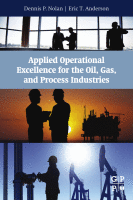Browse content
Table of contents
Actions for selected chapters
- Full text access
- Book chapterAbstract only
1 - What Is Operational Excellence (OE)?
Pages 1-37 - Book chapterAbstract only
2 - Safety Management
Pages 39-80 - Book chapterAbstract only
3 - Interrelationships between SHE (PSM/SMS) and OE Systems
Pages 81-86 - Book chapterAbstract only
4 - Benefits of Integrated PSM/SMS/SHE and OE Programs
Pages 87-114 - Book chapterAbstract only
5 - OE Objectives and Structure
Pages 115-122 - Book chapterAbstract only
6 - OE Typical Elements
Pages 123-138 - Book chapterAbstract only
7 - OE Key Processes and Safety, Health and Environment (SHE) Embedding
Pages 139-146 - Book chapterAbstract only
8 - OE/SHE Key Performance Indicators (KPIs)
Pages 147-163 - Book chapterAbstract only
9 - OE Governance and Implementation
Pages 165-182 - Book chapterAbstract only
10 - Performing an OE/SHE Gap Analysis
Pages 183-192 - Book chapterAbstract only
11 - Assessments and Auditing
Pages 193-204 - Book chapterNo access
Acronyms
Pages 205-206 - Book chapterNo access
Definitions
Pages 207-210 - Book chapterNo access
Bibliography
Pages 211-212 - Book chapterNo access
Index
Pages 213-222
About the book
Description
Applied Operational Excellence for the Oil, Gas, and Process Industries offers a straightforward practical guide for oil and gas companies to understand the comparisons and contrasts between various types of safety management processes, including the standardized structure and ongoing extended benefits that operational excellence can bring to an oil and gas company.
The goal of achieving operational excellence is to reduce costs, improve productivity, and enhance efficiency—in other words, operational excellence contributes to the bottom line. Following along with pre-built success in the process industries, many companies in the oil and gas industry appear to use a subset form of operational excellence, yet many are unsure or unaware of all the safety system components that will truly benefit the company holistically, and current literature is only applicable to the process and manufacturing industries.
Packed with clear objectives and tools, structure guidelines specific to oil and gas, and guidance for how to imbed your existing safety program under the operational excellence umbrella known as "One-Step Merger," this book will help you establish an overall safety culture vision and challenge your organization to achieve higher levels of safety management and overall company value.
Applied Operational Excellence for the Oil, Gas, and Process Industries offers a straightforward practical guide for oil and gas companies to understand the comparisons and contrasts between various types of safety management processes, including the standardized structure and ongoing extended benefits that operational excellence can bring to an oil and gas company.
The goal of achieving operational excellence is to reduce costs, improve productivity, and enhance efficiency—in other words, operational excellence contributes to the bottom line. Following along with pre-built success in the process industries, many companies in the oil and gas industry appear to use a subset form of operational excellence, yet many are unsure or unaware of all the safety system components that will truly benefit the company holistically, and current literature is only applicable to the process and manufacturing industries.
Packed with clear objectives and tools, structure guidelines specific to oil and gas, and guidance for how to imbed your existing safety program under the operational excellence umbrella known as "One-Step Merger," this book will help you establish an overall safety culture vision and challenge your organization to achieve higher levels of safety management and overall company value.
Key Features
- Explores how to solidify a foundational operational excellence program applicable for your oil and gas company
- Clarifies the differences and benefits among various programs under operational excellence (OE), such as SHE (safety, health, and environment), PSM (process safety management), and SMS (safety management system)
- Explains how to audit and consistently assess how oil and gas OE systems are planned, implemented, and managed, with explanations on cost and time impacts as well as administrative protocols
- Includes a glossary, acronym appendix, and additional references for further reading
- Explores how to solidify a foundational operational excellence program applicable for your oil and gas company
- Clarifies the differences and benefits among various programs under operational excellence (OE), such as SHE (safety, health, and environment), PSM (process safety management), and SMS (safety management system)
- Explains how to audit and consistently assess how oil and gas OE systems are planned, implemented, and managed, with explanations on cost and time impacts as well as administrative protocols
- Includes a glossary, acronym appendix, and additional references for further reading
Details
ISBN
978-0-12-802788-2
Language
English
Published
2015
Copyright
Copyright © 2015 Elsevier Inc. All rights reserved.
Imprint
Gulf Professional Publishing
